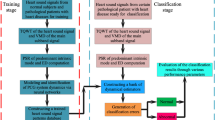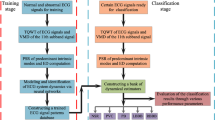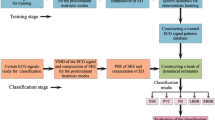Abstract
Heart valve disorders (HVDs) are the major causes of cardiovascular diseases (CVD), which may be detected at the early stage using routine auscultation examination. The phonocardiogram (PCG) is a graphical representation of the physiological condition of the heart, which differs with respect to heart diseases. It is closely related to valve functionality which provides vital information for the diagnosis of CVD. However, visual inspection of PCG is tedious and error-prone, which makes it necessary and urgent to develop an automated system for the detection of HVDs with PCG recordings. In the present study we propose a novel method for the identification and classification of normal and abnormal non-segmented PCG recordings based on hybrid signal processing tools and deterministic learning theory. First, PCG signal and its first derivative are decomposed into a set of frequency subbands with a number of decomposition levels by using the tunable Q-factor wavelet transform method. Second, fast and adaptive multivariate empirical mode decomposition decomposes the subbands of the PCG signal and its derivative into scale-aligned intrinsic mode components (IMFs). The first two IMFs are extracted, which contain most of the energy of the PCG signal and its derivative and are considered to be the predominant IMFs. Third, Shannon energy is used to extract the characteristic envelope of predominant IMFs. The properties associated with the nonlinear PCG system dynamics are preserved. They are utilized to derive features, which demonstrate significant difference in PCG system dynamics between normal versus abnormal individual heartbeats. Fourth, neural networks are then used to model, identify and classify PCG system dynamics between normal and abnormal PCG signals based on deterministic learning theory. Finally, experiments have been carried out on a publicly available PCG database to verify the effectiveness of the proposed method, which include two types of classification, one for binary classification (normal vs. abnormal) and the other for multi-class classification (normal vs. aortic stenosis vs. mitral regurgitation vs. mitral stenosis vs. mitral valve prolapse). The overall average accuracy for binary, four-class and five-class classification are reported to be 97.75, 98.69 and 98.48%, respectively. The proposed method has obtained the highest overall accuracy in comparison to other state-of-the-art approaches using the same database, which can serve as an assistant diagnostic tool for the automated detection of HVDs in clinical applications.











Similar content being viewed by others

Explore related subjects
Discover the latest articles, news and stories from top researchers in related subjects.References
Abduh Z, Nehary EA, Wahed MA, Kadah YM (2020) Classification of heart sounds using fractional Fourier transform based Mel-frequency spectral coefficients and traditional classifiers. Biomed Signal Process Control 57:101788
Alqudah AM (2019) Towards classifying non-segmented heart sound records using instantaneous frequency based features. J Med Eng Technol 43(7):418–430
Altuve M, Suarez L, Ardila J (2020) Fundamental heart sounds analysis using improved complete ensemble EMD with adaptive noise. Biocybern Biomed Eng 40(1):426–439
Ari S, Hembram K, Saha G (2010) Detection of cardiac abnormality from PCG signal using LMS based least square SVM classifier. Expert Syst Appl 37(12):8019–8026
Ari S, Saha G (2009) In search of an optimization technique for artificial neural network to classify abnormal heart sounds. Appl Soft Comput 9(1):330–340
Beyramienanlou H, Lotfivand N (2017) Shannon’s energy based algorithm in ECG signal processing. Comput Math Methods Med 2017:1–16
Boutana D, Benidir M, Barkat B (2011) Segmentation and identification of some pathological phonocardiogram signals using time-frequency analysis. IET Signal Process 5(6):527–537
Castro A, Vinhoza TT, Mattos SS, Coimbra MT (2013) Heart sound segmentation of pediatric auscultations using wavelet analysis. In: 35th annual international conference of the IEEE engineering in medicine and biology society, pp 3909–3912
Cheema A, Singh M (2019) An application of phonocardiography signals for psychological stress detection using non-linear entropy based features in empirical mode decomposition domain. Appl Soft Comput 77:24–33
Cheng X, Wang P, She C (2020) Biometric identification method for heart sound based on multimodal multiscale dispersion entropy. Entropy 22(2):238
Cherif LH, Debbal SM, Bereksi-Reguig F (2010) Choice of the wavelet analyzing in the phonocardiogram signal analysis using the discrete and the packet wavelet transform. Expert Syst Appl 37(2):913–918
Clifford GD, Liu C, Moody B, Springer D, Silva I, Li Q, Mark RG (2016) Classification of normal/abnormal heart sound recordings: the PhysioNet/Computing in Cardiology Challenge 2016. In: 2016 computing in cardiology conference (CinC), pp 609–612
Elamaran V, Arunkumar N, Hussein AF, Solarte M, Ramirez-Gonzalez G (2018) Spectral fault recovery analysis revisited with normal and abnormal heart sound signals. IEEE Access 6:62874–62879
Esmail MY, Ahmed DH, Eltayeb M (2019) Classification system for heart sounds based on random forests. J Clin Eng 44(2):76–80
Gaur P, Pachori RB, Wang H, Prasad G (2018) A multi-class EEG-based BCI classification using multivariate empirical mode decomposition based filtering and Riemannian geometry. Expert Syst Appl 95:201–211
Ghosh SK, Ponnalagu RN, Tripathy RK, Acharya UR (2020) Automated detection of heart valve diseases using chirplet transform and multiclass composite classifier with PCG signals. Comput Biol Med 118:103632
Ghosh SK, Tripathy RK, Ponnalagu RN, Pachori RB (2019) Automated detection of heart valve disorders from the pcg signal using time-frequency magnitude and phase features. IEEE Sens Lett 3(12):1–4
Gorinevsky D (1995) On the persistency of excitation in radial basis function network identification of nonlinear systems. IEEE Trans Neural Netw 6(5):1237–1244
Hamidi M, Ghassemian H, Imani M (2018) Classification of heart sound signal using curve fitting and fractal dimension. Biomed Signal Process Control 39:351–359
Huang NE, Shen Z, Long SR, Wu MC, Shih HH, Zheng Q, Liu HH (1998) The empirical mode decomposition and Hilbert spectrum for nonlinear and non-stationary time series analysis. Proc R Soc Lond A: Math, Phys Eng Sci, R Soc 454(1971):903–995
Karar ME, El-Khafif SH, El-Brawany MA (2017) Automated diagnosis of heart sounds using rule-based classification tree. J Med Syst 41(4):60
Keunen RW, Pijlman HG, Visee HF, Vliegen JH, Tavy DL, Stam KJ (1994) Dynamical chaos determines the variability of transcranial Doppler signals. Neurol Res 16(5):353–358
Khan FA, Abid A, Khan MS (2020) Automatic heart sound classification from segmented/unsegmented phonocardiogram signals using time and frequency features. Physiol Measur 41(5):055006
Lang X, Zheng Q, Zhang Z, Lu S, Xie L, Horch A, Su H (2018) Fast multivariate empirical mode decomposition. IEEE Access 6:65521–65538
Latif S, Usman M, Rana R, Qadir J (2018) Phonocardiographic sensing using deep learning for abnormal heartbeat detection. IEEE Sens J 18(22):9393–9400
Li J, Ke L, Du Q (2019) Classification of heart sounds based on the wavelet fractal and twin support vector machine. Entropy 21(5):472
Li S, Li F, Tang S, Xiong W (2020) A review of computer-aided heart sound detection techniques. BioMed Res Int 2020:1–10
Li BB, Yuan ZF (2008) Non-linear and chaos characteristics of heart sound time series. Proc Inst Mech Eng, Part H: J Eng Med 222(3):265–272
Lubaib P, Muneer KA (2016) The heart defect analysis based on PCG signals using pattern recognition techniques. Proced Technol 24:1024–1031
Naseri H, Homaeinezhad MR, Pourkhajeh H (2013) Noise/spike detection in phonocardiogram signal as a cyclic random process with non-stationary period interval. Comput Biol Med 43(9):1205–1213
Nigam V, Priemer R (2005) Accessing heart dynamics to estimate durations of heart sounds. Physiol Measur 26(6):1005
Oh SL, Jahmunah V, Ooi CP, Tan RS, Ciaccio EJ, Yamakawa T, Acharya UR (2020) Classification of heart sound signals using a novel deep WaveNet model. Comput Methods Progr Biomed 196:105604
Padmanabhan V, Semmlow JL (1994) Dynamical analysis of diastolic heart sounds associated with coronary artery disease. Ann Biomed Eng 22(3):264–271
Patidar S, Pachori RB, Garg N (2015) Automatic diagnosis of septal defects based on tunable-Q wavelet transform of cardiac sound signals. Expert Syst Appl 42(7):3315–3326
Rehman N, Mandic DP (2010) Multivariate empirical mode decomposition. Proc R Soc A: Math, Phys Eng Sci 466(2117):1291–1302
Saeidi A, Almasganj F (2017) 3D heart sound source localization via combinational subspace methods for long-term heart monitoring. Biomed Signal Process Control 31:434–443
Samanta P, Pathak A, Mandana K, Saha G (2019) Classification of coronary artery diseased and normal subjects using multi-channel phonocardiogram signal. Biocybern Biomed Eng 39(2):426–443
SaracOgLu R (2012) Hidden Markov model-based classification of heart valve disease with PCA for dimension reduction. Eng Appl Artif Intell 25(7):1523–1528
Selesnick I (2011) Wavelet transform with tunable Q-factor. IEEE Trans Signal Process 59(8):3560–3575
Shervegar MV, Bhat GV (2018) Heart sound classification using Gaussian mixture model. Porto Biomed J 3(1):e4
Shi K, Schellenberger S, Michler F, Steigleder T, Malessa A, Lurz F, Koelpin A (2019) Automatic signal quality index determination of radar-recorded heart sound signals using ensemble classification. IEEE Trans Biomed Eng 67(3):773–785
Singh SA, Majumder S (2019) Classification of unsegmented heart sound recording using KNN classifier. J Mech Med Biol 19(04):1950025
Son GY, Kwon S (2018) Classification of heart sound signal using multiple features. Appl Sci 8(12):2344
Thayer JF, Yamamoto SS, Brosschot JF (2010) The relationship of autonomic imbalance, heart rate variability and cardiovascular disease risk factors. Int J Cardiol 141(2):122–131
Thirumalaisamy MR, Ansell PJ (2018) Fast and adaptive empirical mode decomposition for multidimensional, multivariate signals. IEEE Signal Process Lett 25(10):1550–1554
Varghees VN, Ramachandran KI (2017) Effective heart sound segmentation and murmur classification using empirical wavelet transform and instantaneous phase for electronic stethoscope. IEEE Sens J 17(12):3861–3872
Wang C, Hill DJ (2006) Learning from neural control. IEEE Trans Neural Netw 17(1):130–146
Wang C, Hill DJ (2007) Deterministic learning and rapid dynamical pattern recognition. IEEE Trans Neural Netw 18(3):617–630
Wang C, Hill DJ (2009) Deterministic learning theory for identification, recognition and control. CRC Press, Boca Raton
Wang Y, Li W, Zhou J, Li X, Pu Y (2014) Identification of the normal and abnormal heart sounds using wavelet-time entropy features based on OMS-WPD. Fut Gener Comput Syst 37:488–495
Xiao B, Xu Y, Bi X, Zhang J, Ma X (2020) Heart sounds classification using a novel 1-D convolutional neural network with extremely low parameter consumption. Neurocomputing 392:153–159
Yadav A, Singh A, Dutta MK, Travieso CM (2020) Machine learning-based classification of cardiac diseases from PCG recorded heart sounds. Neural Comput Appl 32:17843–17856
Zeng W, Yuan J, Yuan C, Wang Q, Liu F, Qang Y (2020) A new approach for the detection of abnormal heart sound signals using TQWT, VMD and neural networks. Artif Intell Rev. https://doi.org/10.1007/s10462-020-09875-w
Zhang W, Han J, Deng S (2017) Heart sound classification based on scaled spectrogram and tensor decomposition. Expert Syst Appl 84:220–231
Zidelmal Z, Amirou A, Ould-Abdeslam D, Moukadem A, Dieterlen A (2014) QRS detection using S-transform and Shannon energy. Comput Methods Progr Biomed 116(1):1–9
Acknowledgements
This work was supported by the National Natural Science Foundation of China (Grant No. 61773194), by the Natural Science Foundation of Fujian Province (Grant No. 2018J01542), by the Training Program of Innovation and Entrepreneurship for Undergraduates (Grant No. 202011312001) and by Fujian Provincial Key Laboratory of Welding Quality Intelligent Evaluation.
Author information
Authors and Affiliations
Corresponding author
Ethics declarations
Conflict of interest
The authors declare that they have no conflict of interest.
Additional information
Publisher's Note
Springer Nature remains neutral with regard to jurisdictional claims in published maps and institutional affiliations.
Rights and permissions
About this article
Cite this article
Zeng, W., Lin, Z., Yuan, C. et al. Detection of heart valve disorders from PCG signals using TQWT, FA-MVEMD, Shannon energy envelope and deterministic learning. Artif Intell Rev 54, 6063–6100 (2021). https://doi.org/10.1007/s10462-021-09969-z
Published:
Issue Date:
DOI: https://doi.org/10.1007/s10462-021-09969-z



